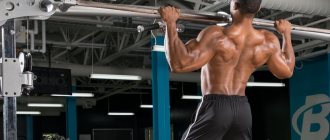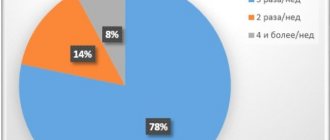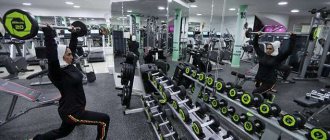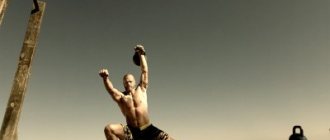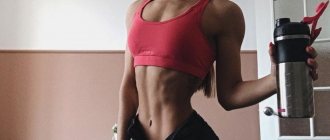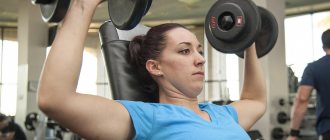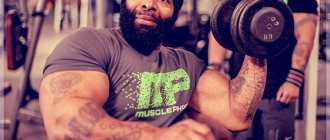Without pumped up and strong legs it is impossible to imagine an attractive athletic figure of a man.
When organizing workouts at home, it is important to include in the complex exercises that allow you to work all muscle groups of the lower extremities.
Exercises should be regular, including moderate strength loads. Working out the leg muscles with properly organized exercises usually takes 4-8 weeks.
Training at home: rules, recommendations, common mistakes
Working on the leg muscles is important for all men, regardless of their age, lifestyle and level of physical fitness.
Why is it important to have trained muscles of the lower extremities:
- the level of physical endurance increases;
- the correct position of the pelvis is created;
- provides prevention of varicose veins and thrombophlebitis;
- metabolism accelerates, fat deposits are burned faster.
During leg workouts, the muscles of the buttocks and thighs are used. You can organize at home without visiting the gym.
Important! First of all, the loads must be regular. It is optimal to devote 3-4 days a week to leg fitness, maintaining equal intervals between sessions. The recommended duration of one lesson is 40 minutes.
To choose the right leg exercises for men, performed at home, you need to know what the muscles of the lower extremities are. It includes a large number of large, medium and small muscles that have a close relationship with each other.
A men's leg workout should include fitness techniques that work the following muscle groups:
- quadriceps (front of thighs);
- the hamstring muscles located under the buttocks;
- buttock muscles;
- soleus and gastrocnemius muscles.
The muscles of the legs are of the slow type. She quickly adapts to the monotonous loads associated with running, standing and walking. To gain sculpted muscles in the legs, they need to be subjected to strength loads, which help to use all the muscles of the limbs during one workout.
If a man has excess fat deposits in the thighs, calves and buttocks, then just doing strength exercises will not get rid of excess weight. You can pump up noticeable muscles in the lower extremities only after losing weight.
Important! Proper nutrition with a limited calorie diet and the exclusion of saturated fats and simple carbohydrates will help eliminate excess fat. Cardio exercises, which you need to devote about 30 minutes daily, will help speed up your metabolism, thereby starting the fat burning process.

Basic recommendations for organizing training at home:
- Before each session, you need a five-minute warm-up to warm up your muscles and tendons. Ignoring fitness techniques to prepare muscles for exercise significantly increases the risk of injury.
- The complex should consist of fitness techniques for pumping all muscle groups of the lower extremities.
- provided regular and proper training is possible in at least a month. There are no sets of fitness techniques that allow you to achieve the desired result in a few days.
- A diet that includes protein nutrition helps to increase the effectiveness of exercise. Sufficient amounts of proteins help build muscle.
- Alternating strength training with cardio exercises will help normalize metabolism and increase physical endurance.
Typical mistakes of men who intend to pump up the muscle tissue of the lower extremities:
- the desire to achieve results within a few weeks, focusing on grueling training;
- daily classes seven days a week;
- reduction of the knee joints when performing squats of any degree of difficulty;
- hunched back when performing lunges and squats.
Correctly organized training allows you to avoid problems with joints and tendons, as well as harmoniously pump up the muscles of the lower extremities.
Swing your legs
Full muscle pumping should include leg swings. While standing, move your leg as high back as possible, to the side. While lying on your side or on all fours, swing your legs up and to the side, alternately changing legs. At home, you can increase the load by stretching a circle of elastic band while abducting your leg.
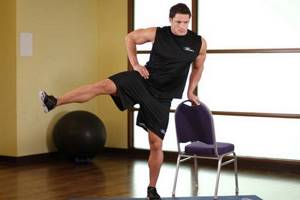
Swing your legs to the side
The intensity and duration of classes depends on whether you want to pump up your legs or lose weight. You should review your diet and balance your diet. Leg exercises at home are no less effective than working out in the gym. Although it may take longer to achieve the desired result.
Effective loads for the calf muscles and thighs
Each fitness technique from the complex should ensure a full pumping of the leg muscles.
The table shows the best exercises for different muscle groups of the lower extremities for men:
| Muscles | Exercises | Execution technique |
| Calves and soleus muscles | Calf raises | The legs are placed together, and the hands are on the belt. As you exhale, tense your calves and lift them onto your toes, and as you inhale, lower your feet to the floor. It is recommended to do 20 rhythmic repetitions in one approach. |
| Pulling your legs towards your buttocks (you will need a dumbbell weighing up to 2 kg) | You need to lie on your stomach on the floor. A dumbbell is held between the feet. As you exhale, bend the limbs at the knee joints, pulling the feet with the load towards the buttocks. It is optimal to perform 15 repetitions in 2-3 approaches. | |
| Muscles of the thigh and buttocks | Squats | Place your hands behind your head and straighten your posture as much as possible. The legs stand at the same width as the shoulders. The feet and knee joints must be at the same level. As you exhale, spread your knees and squat, bringing your pelvis as close to the floor as possible. The foot rests completely on the floor. As you inhale, return to the starting position. It is optimal to do at least 15 repetitions in 3 sets. You can complicate the fitness routine with dumbbells. |
| Scissors | Take the same position as for performing lunges. As you exhale, make a high jump, changing the position of your limbs in the air. During landing, they rely on the limb set back. The landing should be soft. This exercise is repeated 15-20 times. | |
| Spring lunges with dumbbells | You need to stand up straight with your feet shoulder-width apart. The knee joint of the leg extended forward is bent at a right angle. The second leg stands behind in line with the other limb. Take dumbbells in your hands and straighten your limbs “at the seams.” As you exhale, strain your thigh and squat down, lowering the knee of the leg laid back to the floor. As you inhale, you need to get into the starting position. Do 15 repetitions for each limb. | |
| Gluteal bridge | Lie on your back and place your arms along your body. With your feet fully on the floor, place them shoulder-width apart, bending your limbs at the knee joints. As you exhale, tensing the muscles of your shoulder blades and calves, lift your buttocks and hold them at the peak point for several seconds. As you inhale, lower the sacrum to the floor. The fitness technique is repeated 15-20 times in 2-3 approaches. The advantage of this exercise is that it also puts stress on the calf muscles. |
On days free from training, you can pay attention to half-hour cardio exercises, during which the muscles of the lower extremities are involved. In the morning, you can organize a run at a moderate pace. If this is not possible, then jogging is replaced by walking at a fast pace. Cycling is also the best option.
Basic principles
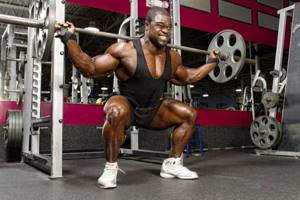
Leg muscle training should begin with basic exercises. If you start training based on an isolated principle, then in the future you will not be able to master basic movements, which will reduce the effectiveness of training as a whole. Some beginners do this, after which disappointment sets in and, as a result, they quit training. Before starting the training process, it makes sense to start performing basic movements with a minimum load, as a warm-up before the main basic work.
When working with a maximum load, it is advisable to wear an athletic belt, otherwise you can overload your back muscles. In addition, it is advisable to protect the knee joints with bandages, since they experience serious stress. It is realistic to train your legs with an optimal load, so choosing the maximum weight is not recommended.
Before starting training, it is advisable to familiarize yourself with the technique of performing movements. As a rule, it will take weeks, or even months, to perfectly master the technique of performing movements. Under no circumstances should such an approach to the training process be ignored. The final result directly depends on the technique of movement. In addition, during this initial period you should not take risks and use large masses of sports equipment. Weight gain should be smooth and deliberate.
Rules for organizing training
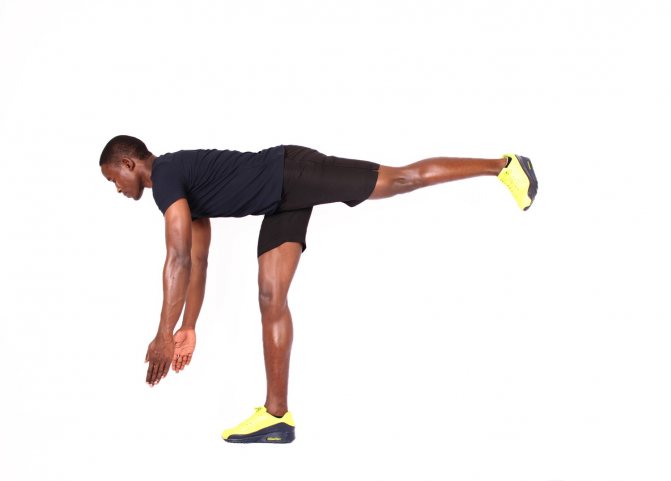
An exercise with an emphasis on the muscles of the legs begins with a warm-up. Its duration is 5-10 minutes, and it includes light exercises such as jumping, running in place, and circular rotations with toes placed on the floor.
The main training begins by performing fitness techniques to work out the lower part of the legs - the calf and soleus muscles. It is optimal to perform 2 effective exercises for these muscles.
At the next stage, lunges and squats are performed, the number of repetitions and approaches of which depends on the general athletic training of the man.
In the middle of the class, you can pay attention to cardio training, for example, jumping rope. You can finish the training with an exercise performed in a lying position. The best option in this case would be a gluteal bridge.
The total duration of the training is 30-40 minutes.
Leg training for weight
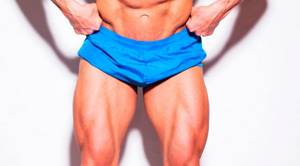
If you're interested in hypertrophy and want to grow your leg muscles, but don't know what exactly to do, we have a great workout program for you! Each movement has a number of repetitions for strength and mass, depending on your goals.
Please note that cardio training can give a good boost to the synthesis of muscle fibers, and will definitely help burn excess fat if all the rules are followed.
The complex will help you build muscle, increase strength, and the next morning you will feel like you did a great job. To get maximum results and avoid injury, you need to learn the technique of performing basic exercises and stick to it during training. They are more effective than isolation ones (although they are also needed, and it is better for a beginner to start with them to strengthen and prepare ligaments, joints and muscles for heavy weights), but at the same time they require perfect technique to avoid injury.
What are you waiting for?
Let's go shake our legs!
The best complexes: 3 options
One complex includes 3-4 exercises performed in 3 approaches. Each fitness move takes 3-4 minutes to complete. A mandatory warm-up period of at least 5 minutes is given at the beginning of the lesson. The same amount of time is allocated for 1 cardio exercise.
First complex:
- warm-up – 5 minutes;
- raising on toes while sitting on a chair with weights on the front surface of the thigh - 15 repetitions in 3 sets;
- squats with dumbbells weighing 1 kg in each hand – 10 repetitions in 3-4 sets;
- scissors with jumping – 20 repetitions in 3 sets;
- cardio – 3 minutes;
- gluteal bridge – 15 repetitions in 3 sets.
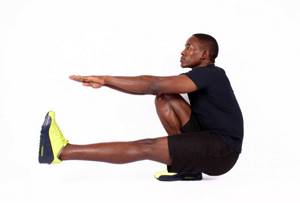
Second complex:
- warm-up – 5 minutes;
- classic calf raises in a standing position - 20 repetitions in 3 sets;
- lunges with dumbbells – 10 repetitions in 4 sets;
- squats without dumbbells - 15 repetitions in 3 sets;
- cardio – complicated “bicycle” exercise (15 repetitions in 3 sets);
- gluteal bridge – 15 repetitions in 3 sets.
Third complex (the most difficult, for advanced athletes):
- warm-up – 5 minutes;
- pulling the legs to the buttocks (dumbbell weight – 2 kg) – 15 repetitions in 3 sets;
- lunges with dumbbells – 20 times in 3 sets;
- squats with dumbbells – 15 times in 3 sets;
- scissors – 10 repetitions in 2 sets;
- Bulgarian squats, which are lunges in which the leg is pulled back and stands on a stool - 10 repetitions in 3 sets;
- jumping rope – 5 minutes;
- gluteal bridge – 15 repetitions in 2 sets.
Exercises should be comfortable, causing slight swelling in the muscles of the legs. In case of acute pain in the joints, stop training immediately.
Leg press will never replace squats
For every bodybuilder who loves to train legs and does squats regularly, there are a dozen athletes who hate them. I know because I am like that myself. I'm looking for any excuse not to squat. A favorite excuse is to convince yourself that the leg press is as good as the squat. After all, it involves the same muscle groups and I can lift a ton of iron!
Of course, just because the knees and hips are flexed, the leg press does not become equal to the squat. “There is no doubt that the squat is more challenging and recruits more muscle fibers than the leg press,” says Hildebrand. “The squat requires the entire kinematic chain to engage all muscles simultaneously, making it superior in terms of functionality, mass and strength development.”
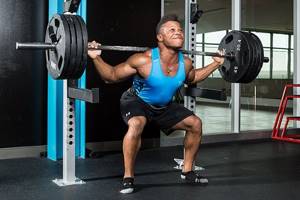
Squats release more hormones than bench presses, no matter how many sets you do.
Hildebrand emphasizes that squats with appropriate volume and intensity optimize the natural secretion of anabolic hormones. After multi-joint exercise, athletes have higher levels of growth hormone and testosterone in their blood than after exercise that loads less muscle mass. There is a direct relationship between the amount of testosterone produced and the amount of muscle mass involved in performing the movement.
Although the battle between free weight squats and machine squats has ended in favor of free weights, you don't have to limit yourself to just high bar squats, which are often called bodybuilder squats. Front squats (with a barbell on the chest) will help shift the emphasis from the buttocks to the quadriceps by moving the center of gravity forward.
In low bar powerlifter squats, you lower the barbell lower to the level of your rear delts rather than your traps. This forces you to lean forward more and shifts your center of gravity slightly. You'll immediately be able to lift more weight simply by increasing glute and hamstring engagement and less lower quadriceps activation.
Other useful variations of free weight squats are sumo squats, kettlebell squats, and goblet squats.
Recommendations from coaches and athletes
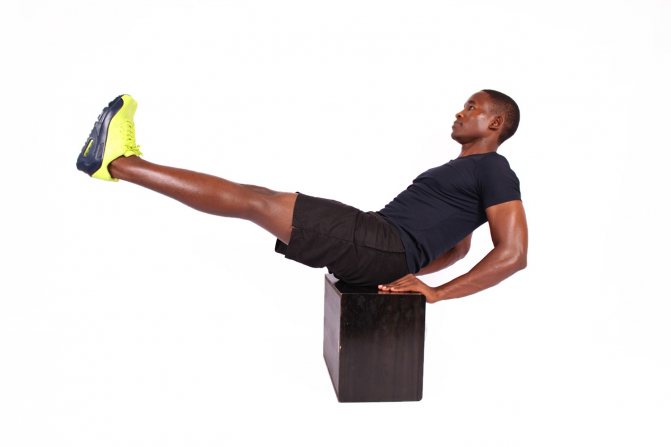
Fitness experts will tell you the key nuances of organizing training to pump up the muscles of the lower extremities.
Alexey Khodonovich, fitness blogger
He recommends starting your home workout with jumping squats. This fitness move activates both the thigh and calf muscles.
Demin Vlad, fitness trainer, author of a video channel dedicated to home training
Squats with your own weight are a basic training exercise for the leg muscles, during which a lot of mistakes are made. You need to squat with a straight back. The knee joints should not extend beyond the line of the feet. Squats are always performed at a smooth pace, without jerking.
Squats
You can quickly pump up your legs using various variations of squats. Increasing the number of repetitions with each workout and reaching 100 squats, it is recommended to perform them with weights.
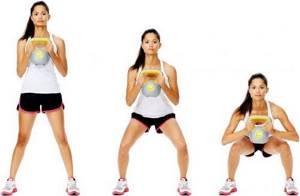
You can squat with or without weight
You can use dumbbells or a barbell for this. To pump up your legs at home, you can use plastic containers of various sizes filled with sand or water as additional weight.
It is important to follow the execution rules. The body must be kept straight and the back straight. During a squat, your thighs should be parallel to the floor. When squatting, you cannot push your knees further than your toes.
We have previously written about exercises for girls to pump up their legs at home and recommended bookmarking this article.
Do not squat with your heels on a board or plates
Have you ever asked yourself why a guy squats with his heels on a board or small plates? With your heels raised, your center of gravity shifts slightly forward, causing your knees to move forward more during the transition to the bottom position. This shifts the emphasis of the exercise to the lower quadriceps. But the story doesn't end there. At the same time, the load on the cartilage and ligaments of the knee joints increases.
If your knees are fine, it's no big deal—at least not yet. But almost all experienced powerlifters suffer from knee pain, so knowing about safer squat options definitely doesn't hurt.
“During squats, the load on the knee joint is already very high. Putting your heels on the board can do more harm than good. says Brooke Erickson, IFBB Professional Fitness Model. “Biomechanics plays a major role in the longevity of your joints, no matter how healthy they are currently.”
By far the best way to evaluate your technique for knee safety is to place your feet on the floor or platform of the machine and, during the downward phase, check that your knees do not extend beyond the imaginary plane that passes through your toes. (When doing hack squats, this plane is at a slight angle).
If your knees move out of the imaginary plane, you are putting unwanted stress on the joint. Move your feet. You'll likely need to raise them higher on the platform or further back when performing other exercises, step-ups or lunges, so that you don't cross the plane of your toes. For lunges, this means you'll just have to take a slightly wider step.
Use specific exercises for the hamstrings
Some people think that squats and other leg extension movements are enough to pump up the hamstrings. Meanwhile, research shows that although the posterior surface is involved in squats, the load on it is very limited.
“Specific exercises for mass and growth of the posterior muscles are important and should be included in a weekly leg routine,” says Erickson. “Additional exercises for the posterior area are good not only from an aesthetic point of view, but also for the development of speed and strength and the prevention of injuries to the knees, hips and lower back muscles.”
Most of us are familiar with the group of leg curl exercises that target the posterior muscles. They can be performed sitting, standing, lying down, with support, or alternating with one leg. All of them are good for strengthening the hamstrings.
Erickson knows that hamstring injuries can be very frustrating. When a muscle group is relatively weak (compared to the quadriceps), there is a high risk of experiencing an anterior cruciate ligament injury or muscle strain. To promote knee stability and health, the quadriceps (the antagonist flexor muscles of the knee joint) should be stronger at a ratio of approximately 3:2 (they are stronger because they are used more and more often in daily activities).
You can figure this out by measuring your strength: If your max in leg extensions (a single-joint movement for the quads) is 10 reps with 70kg, you should be able to do the same 10 reps with 45kg in bench leg curls. If you can't bend your legs 10 times, your knees are more vulnerable to injury. At the very least, you should be aware of this so you can focus your efforts on the weak link.
Because it's normal for women to have a lower ratio of quadriceps to hamstring strength—and female athletes have an even lower ratio—they are even more at risk for muscle strains and ACL injuries.
FYI, here's how the hamstrings work during a squat: By controlling the downward phase as your hips descend to the bottom of the squat, the quadriceps muscle fibers stretch and the hamstrings contract. The deeper you go, the more muscle fibers on the back surface are activated.
Additionally, the hack squat platform, squat machine, bench squat, and even the leg press can allow you to place your feet very high. This reduces quadriceps activation and increases stress on the glutes and flexors. But you still need to add specific exercises for the hamstrings.
Change the position of your feet to change the emphasis of the exercise.
Many of us pay little attention to the position of our feet during leg exercises. We place them somewhere between hip width and shoulder width and turn them outward a little. There is no doubt that this is a solid foundation from which to build.
But many leg exercises, especially machines, allow you to use a greater range of leg positions. Wide or narrow, high or low, or even exactly in the center. Does it matter? One hundred percent!
If you place your feet too low on the platform, you run the risk of your knees extending beyond the plane of your toes. With this position of the feet, the load on the muscles around the knee joint increases and the load on the gluteal muscles decreases. This leads to more quadriceps activation and less glute activation.

Movements with wide feet work on the inner surface more strongly; on the contrary, a narrow leg position more effectively loads the muscles of the outer thigh
By analogy, by raising your feet higher, you increase the degree of flexion and extension in the hip joints and reduce the range of motion in the knees. Therefore, you train your gluteal muscles and upper hamstrings more effectively. Remember, this shift in emphasis is very relative. You can't completely isolate any one muscle.
Movements with wide feet work on the inner surface more strongly; on the contrary, a narrow leg position more effectively loads the muscles of the outer thigh. Regardless, you've just learned about a ton of leg exercise options that are especially helpful when using machines.
